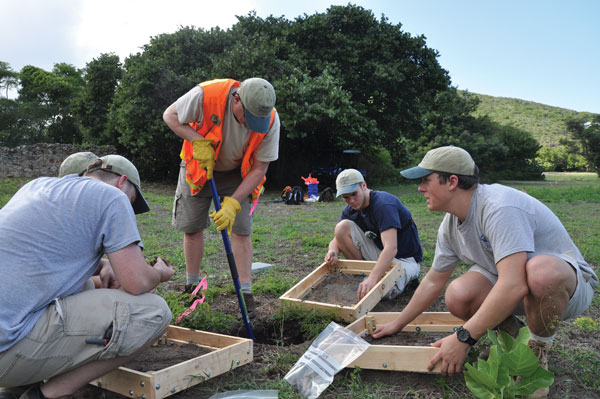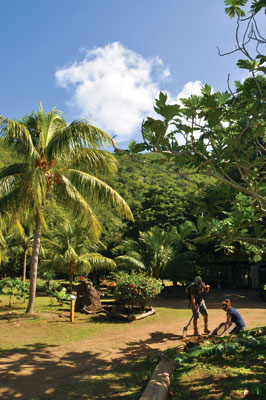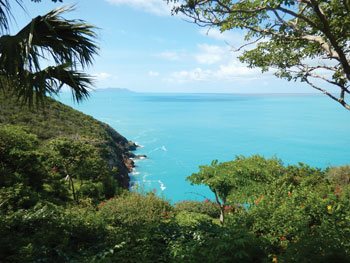Project on private Caribbean island among first for Institute of Archaeology

Guana Island serves as a picturesque backdrop for work by Dr. Brian Bates ’92 (standing), director of Longwood’s new Institute of Archaeology, and students Jordan Wilson ’17 (left),Tyler Rocke ’16 and Daniel Parrish ’17. Guana Island. Photo Credit: Mary Farrell ’09

Longwood’s new Institute of Archaeology kicks off with a project in the Caribbean. Photo by Dr. Brian Bates ’92.
The Guana Island work is the third project undertaken by the institute, which was founded in September 2015 by Bates. Staffed by three Longwood-trained archaeologists, the institute is self-supporting and provides undergraduates with practical, real-world experience.
“The institute seeks to engage students on a deeper level,” said Bates, executive director and senior principal investigator. “To be in the field and to use sophisticated equipment like we did on Guana gives students a much better understanding than if they had learned in the classroom.”
Farrell echoed Bates’ enthusiasm about the Guana Island project. “Because it was a pristine location, it was a great place to conduct research. It was a phenomenal experience that produced great results,” she said.
Working in a lowland area called “the flats”—like most Caribbean islands, Guana is dominated by steep hills—the Longwood archaeologists performed a geophysical survey of about one acre and an archaeological survey of about 23 acres.
The archaeological survey consisted of a typical shovel test pit survey, in which they dug holes about 1 meter deep every 15 meters on a grid across the flats.
“To be in the field and to use sophisticated equipment like we did on Guana gives students a much better understanding than if they had learned in the classroom.”
— BRIAN BATES ’92, PROFESSOR OF ANTHROPOLOGY
For the geophysical survey, they were helped by two geophysicists from Naeva Geophysics of Charlottesville. The geophysicists taught the students how to use the equipment for a magnetometer survey and a ground-penetrating radar survey, which Bates called “unprecedented at the undergraduate level.”
The team identified two prehistoric archaeological sites, both occupied by Taino Indians from about 700 A.D. to about 1400 A.D. We knew there was something on Guana Island. Now, because of our week there, we know there’s a lot there,” Bates said.
The students who went to Guana Island were anthropology majors Kristin Converse ’17 of Cartersville, Daniel Parrish ’17 of Glen Allen, Tyler Rocke ’16 of Virginia Beach and Jordan Wilson ’17 of Powhatan.
Everyone from Longwood stayed at Guana’s stylish 36-guest resort, which Bates said is about all there is on the island.”

Guana Island. Photo Credit: Dr. Brian Bates ’92
Other institute projects include a shoreline erosion project in the Northern Neck and the Middle Peninsula, and a survey of Cedar Grove, an early 19th century plantation in Mecklenburg County, completed in December 2015. Funding came from a variety of sources, including the National Park Service and the National Trust for Historic Preservation.
In addition to Farrell, the other institute staff members are Craig Rose ’00, principal investigator, and Erin West ’09, field supervisor. All three have master’s degrees in archaeology (Farrell from Ball State University, the other two from University College London, where Bates earned his master’s and Ph.D.).
—Kent Booty
